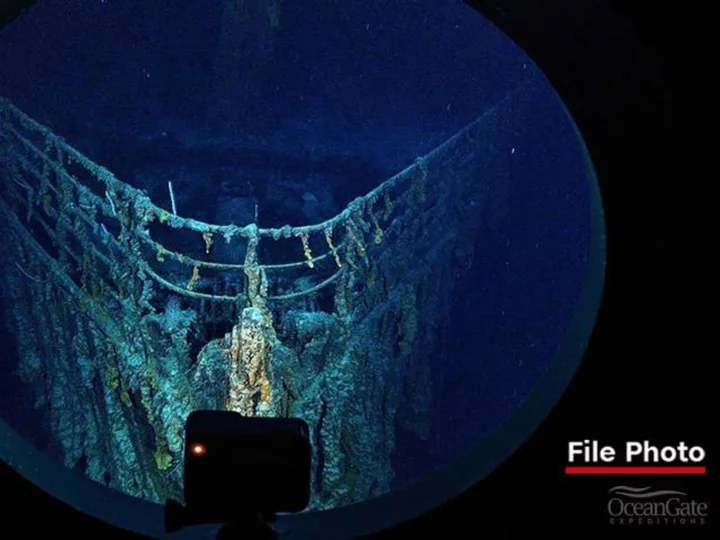Though it's roughly the size of a minivan, with five adults aboard, the Titanic-touring submersible that went missing Sunday may seem small and cramped. And on the dive thousands of feet towards the bottom of the North Atlantic ocean, life inside can go from hot to cold, too.
Known as "Titan," the vessel began the two and a half hour descent to the famous wreckage early Sunday when it lost contact with its mother ship, the Polar Prince, an hour and 45 minutes into the journey.
A submersible -- unlike a submarine -- has limited power reserves and needs a support ship on the surface to launch and recover it. Titan typically spends about 10 to 11 hours during each trip to the Titanic wreck, while submarines can stay underwater for months.
True to its name, Titan weighs 23,000 pounds and is made of carbon fiber and titanium, with safety features to monitor the structural integrity of the vessel, according to its operator, OceanGate Expeditions.
It begins each trip with 96 hours of life support, which has made Thursday morning a key target for the multinational team of rescuers racing to find the vessel and its passengers.
British businessman Hamish Harding, French diver Paul-Henri Nargeolet, Pakistani billionaire Shahzada Dawood and his son Suleman Dawood have all been confirmed to be on board, though authorities have not released their names. The fifth person is OceanGate CEO and founder Stockton Rush, according to a source with knowledge of the mission plan.
Ret. Navy Capt. David Marquet, a former submarine captain, told CNN Wednesday he imagines the five men aboard are experiencing thirst and hunger, and are likely to be very uncomfortable.
Here's what we know about what it's like inside the submersible.
'Not your grandfather's submersible'
Titan is sparse on the inside, according to CBS correspondent David Pogue, who took a trip on Titan down to the Titanic wreck last year.
There is only one toilet, and no seats; its maximum of five passengers must sit cross legged on the floor. There are no windows except the porthole through which passengers view the Titanic.
Rush, the OceanGate CEO, told Pogue during a 2022 interview it's "customary" for crew members to take their shoes off inside the vessel.
"This is not your grandfather's submersible," Rush said. "We only have one button -- that's it. It should be like an elevator; it shouldn't take a lot of skill."
With no GPS underwater, Titan communicates with its mother ship by text messages, and the submersible is required to communicate every 15 minutes, according to OceanGate Expeditions' archived website. The last communication between the vessel and the Polar Prince came in at 11:47 a.m. Sunday.
"All those things we're used to now -- GPS, Wi-Fi, radio links -- do not work under the ocean," former Navy submarine officer Capt. J. Van Gurley told CNN.
Operated by 'gaming controller'
Parts of Titan are decidedly low-tech.
"It is operated ... by a gaming controller, what essentially looks like a PlayStation controller," said CNN correspondent Gabe Cohen, who sat in Titan in 2018 while reporting on OceanGate Expeditions for CNN affiliate KOMO.
The game controller is used for wireless control, according to Aaron Newman, an investor in OceanGate who went down to Titanic on Titan in 2021. If the remote fails, the propellers can be controlled through an internal hard-wire system, Newman said.
The craft operates under strict orders to keep distance from the Titanic wreckage to avoid getting entangled or trapped in the debris, he added.
Titan 'is designed to come back up'
Titan is held underwater by ballast -- heavy weights that helps with a vessel's stability -- built to be automatically released after 24 hours to send the sub to the surface, said Newman.
"It is designed to come back up," he told CNN.
Crew members are told they can release the ballast by rocking the ship or use a pneumatic pump to knock the weights free, Newman said. If all else fails, he said, the lines securing the ballast are designed to fall apart after 24 hours to automatically send it back to the ocean's surface.
Titan's thrusters are powered by an external electrical system, while an internal system powers communications and a heater, Newman said. After boarding the Titan, temperatures inside the vessel get hot quickly before starting to get colder as it descends towards the ocean's bottom, he said.
Temperatures in the deep ocean are just above freezing.
"The quarters are tight -- hot near the surface of the water and nearly freezing in the depth," Newman said, adding that crew members can sit on a low ledge inside the vessel to look through the porthole.
"There is a heater in (Titan), so it can heat up a little bit, but obviously that's not going to last forever," he said. "And obviously, if it's dark, that's probably very difficult on your mental state."
If the submersible stays in deep waters too long, hypothermia could be an issue, said David Gallo, senior adviser for Strategic Initiatives, RMS Titanic. "It's like a visit to another planet, it's not what people think it is. It is a sunless, forever cold environment -- high pressure."









